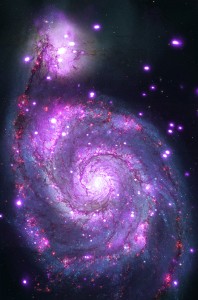Kilgard Presents Stunning New Image of ‘Whirlpool Galaxy’

 Roy Kilgard, support astronomer and research assistant professor of astronomy, together with Trevor Dorn-Wallstein ’15 and Tyler Desjardin MA ’11, recently presented stunning new images of a spiral galaxy produced by combining data from more than 232 hours of observing time with NASA’s Chandra X-ray Observatory. Similar to the Milky Way, the galaxy is officially known as Messier 51 (M51) or NGC 5194, but nicknamed “the Whirlpool Galaxy.” Located about 30 million light years from Earth, its face-on orientation to Earth offers a perspective astronomers can never get of our own galaxy.
Roy Kilgard, support astronomer and research assistant professor of astronomy, together with Trevor Dorn-Wallstein ’15 and Tyler Desjardin MA ’11, recently presented stunning new images of a spiral galaxy produced by combining data from more than 232 hours of observing time with NASA’s Chandra X-ray Observatory. Similar to the Milky Way, the galaxy is officially known as Messier 51 (M51) or NGC 5194, but nicknamed “the Whirlpool Galaxy.” Located about 30 million light years from Earth, its face-on orientation to Earth offers a perspective astronomers can never get of our own galaxy.
The image showing a vibrant purple swirl was presented June 3 at the 224th meeting of the American Astronomical Society in Boston, Mass. K.D. Kuntz of Johns Hopkins University was also a co-author.
The image also appeared as NASA’s Astronomy Picture of the Day on June 10.
Kilgard told Universe Today, “This is the deepest, high-resolution exposure of the full disk of any spiral galaxy that’s ever been taken in the X-ray.”
Chandra allowed the astronomers to uncover things that can only be detected in X-rays. According to the website for the Chandra observatory: “Most of the X-ray sources are X-ray binaries (XRBs). These systems consist of pairs of objects where a compact star, either a neutron star or, more rarely, a black hole, is capturing material from an orbiting companion star. The infalling material is accelerated by the intense gravitational field of the compact star and heated to millions of degrees, producing a luminous X-ray source. The Chandra observations reveal that at least ten of the XRBs in M51 are bright enough to contain black holes. In eight of these systems the black holes are likely capturing material from companion stars that are much more massive than the Sun.”
Observations have revealed that the Whirlpool Galaxy is in the process of merging with a smaller companion galaxy, visible in the upper left of the composite image. Researchers believe this is triggering waves of rapid star formation.
Read more coverage of the presentation on NBC News and Space.
Also at the American Astronomical Society meeting, Nicole Arulanantham, a second-year graduate student in the Astronomy MA program, was awarded a Chambliss Medal, and astronomy major Ben Tweed ’13 presented a paper. Read more about it here.

